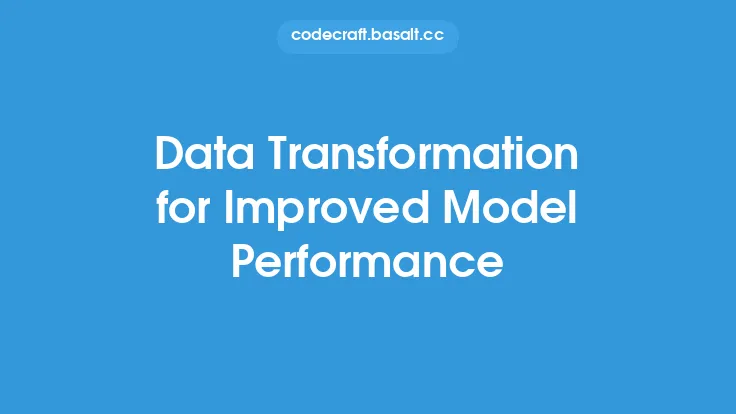Feature engineering is a crucial step in the machine learning pipeline, as it enables the transformation of raw data into meaningful features that can be used to train effective models. The goal of feature engineering is to extract relevant information from the data and represent it in a way that is easily understandable by machine learning algorithms. In this article, we will delve into various feature engineering techniques that can be used to improve model performance.
Introduction to Feature Engineering Techniques
Feature engineering techniques can be broadly categorized into two types: feature transformation and feature construction. Feature transformation involves transforming existing features into new ones, while feature construction involves creating new features from scratch. Some common feature transformation techniques include normalization, scaling, and encoding. Normalization involves scaling numeric features to a common range, usually between 0 and 1, to prevent features with large ranges from dominating the model. Scaling involves transforming numeric features to have zero mean and unit variance, which can improve the stability of some algorithms. Encoding involves converting categorical features into numeric ones, which can be done using techniques such as one-hot encoding or label encoding.
Handling Missing Values
Missing values are a common problem in machine learning datasets, and handling them effectively is crucial for improving model performance. There are several techniques for handling missing values, including mean imputation, median imputation, and imputation using regression. Mean imputation involves replacing missing values with the mean of the respective feature, while median imputation involves replacing missing values with the median of the respective feature. Imputation using regression involves training a regression model to predict the missing values based on other features. Another technique is to use a machine learning algorithm that can handle missing values, such as a random forest or a gradient boosting machine.
Feature Selection
Feature selection is the process of selecting a subset of the most relevant features to use in the model. This can improve model performance by reducing overfitting and improving the interpretability of the results. There are several techniques for feature selection, including filter methods, wrapper methods, and embedded methods. Filter methods involve selecting features based on their correlation with the target variable, while wrapper methods involve selecting features based on their performance on a held-out dataset. Embedded methods involve selecting features as part of the training process, such as using a regularization technique like L1 regularization.
Dimensionality Reduction
Dimensionality reduction is the process of reducing the number of features in the dataset while preserving the most important information. This can improve model performance by reducing overfitting and improving the speed of training. There are several techniques for dimensionality reduction, including principal component analysis (PCA), t-distributed Stochastic Neighbor Embedding (t-SNE), and autoencoders. PCA involves projecting the data onto a lower-dimensional space using the principal components, while t-SNE involves projecting the data onto a lower-dimensional space using a non-linear transformation. Autoencoders involve training a neural network to compress the data into a lower-dimensional space and then reconstruct the original data.
Feature Construction
Feature construction involves creating new features from existing ones. This can be done using various techniques, such as polynomial transformations, interaction terms, and Fourier transforms. Polynomial transformations involve creating new features by raising existing features to a power, while interaction terms involve creating new features by multiplying existing features together. Fourier transforms involve creating new features by transforming existing features into the frequency domain. Another technique is to use domain knowledge to create new features that are relevant to the problem at hand.
Text Feature Engineering
Text data is a common type of data in machine learning, and feature engineering is crucial for improving the performance of text-based models. There are several techniques for text feature engineering, including bag-of-words, term frequency-inverse document frequency (TF-IDF), and word embeddings. Bag-of-words involves representing text data as a bag of words, where each word is a feature, while TF-IDF involves weighting the importance of each word based on its frequency in the document and its rarity in the corpus. Word embeddings involve representing words as vectors in a high-dimensional space, where semantically similar words are close together.
Time Series Feature Engineering
Time series data is another common type of data in machine learning, and feature engineering is crucial for improving the performance of time series-based models. There are several techniques for time series feature engineering, including time domain features, frequency domain features, and wavelet transforms. Time domain features involve extracting features from the time series data, such as the mean, variance, and autocorrelation, while frequency domain features involve extracting features from the frequency spectrum of the time series data. Wavelet transforms involve transforming the time series data into the time-frequency domain using a wavelet transform.
Conclusion
Feature engineering is a crucial step in the machine learning pipeline, and using the right techniques can significantly improve model performance. By applying the techniques outlined in this article, practitioners can extract relevant information from their data and represent it in a way that is easily understandable by machine learning algorithms. Whether it's handling missing values, selecting the most relevant features, reducing dimensionality, constructing new features, or engineering text or time series data, feature engineering is an essential part of building effective machine learning models. By mastering these techniques, practitioners can unlock the full potential of their data and build models that drive real-world impact.





